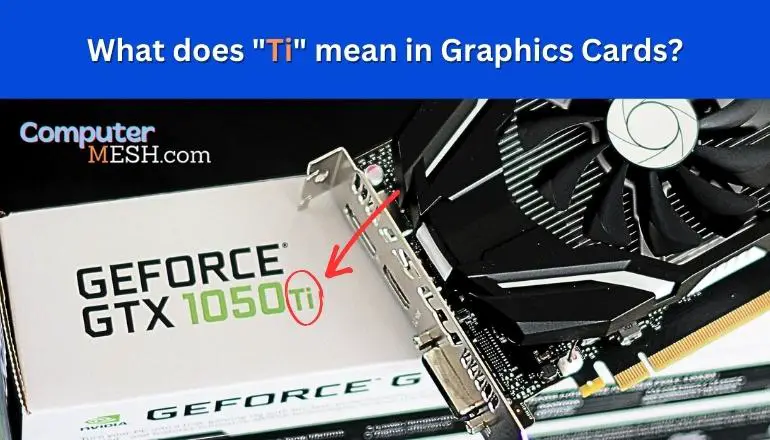What does “Ti” mean in Graphics Cards? » ComputerMesh
Have you ever wondered about the GPU model with “Ti” in the series? Today I will analyze what does Ti mean in GPU (particularly comes with Nvidia cards). Also, what difference does it make if having “Ti” and not having it, and what will be the performance results if comparing ‘Ti’ with ‘Super.’
What does Ti Mean in GPU?

Nvidia’s Graphic cards model with “Ti” represents the highest performance class among GPU series. Here ‘Ti’ is a short form for ‘Titanium,’ a metal known for its strength, durability, and lightness.
The Ti prefix is only used on GeForce GTX-series and RTX series GPU cards and is rarely seen in the budget GT and mid-range GTS. Some users believe that “Ti” indicates factory-overclocked video chips, but that’s not entirely true.
The Ti designation means the original card has been improved with a modified graphics processor that typically has more CUDA cores and a higher clock speed, which allows them to process more data in less time. In most cases, the ‘Ti’ GPUs are 5-20% more powerful than their base model, although this can differ from card to card and its specific configuration.
The differences can be seen in 1080. According to the sensations, the Ti version of this graphic card works a little faster than the “original.” At the same time, the declared frequency of the chip is the same as that of the base model. This could be because the Ti version has more logical blocks, resulting in faster information processing.
The power consumption of recent Ti model GPUs can be about 250W to 450W with GPU alone (such as RTX 3080Ti). Undoubtedly, everything required needs to be powerful, such as the recommended PCIe power supply connector being able to draw 650W or more. It is a graphics board for high-end PCs.
Therefore, the price often increases considerably, and it is not uncommon for the latest model to cost several hundred bucks or more.
Ti vs. Super, Where does Super stand?
Any GPU model with the prefix “SUPER” is positioned in the middle as per the performance, higher than the original model and more modest than Ti. That is, the Ti variant of a GPU is superior to the Super variant regarding performance & benchmark score.
Let’s use the RTX 2080 graphics card as an example. It has all three variants: the base model, SUPER, and Ti.
While 2080 is already a high-end model, SUPER has better performance than the base one, and Ti has even better performance with more RAM than SUPER and the base model. So if a GPU has the term SUPER or Ti after the model number, it means it has higher performance than the base model with the same number but without SUPER or Ti.

In most cases, as the performance of SUPER and Ti increases, the price and power consumption of the GPU itself also increases. In the case of RTX 2080, the power consumption is 215W for regular 2080 and 250W for SUPER and Ti. Therefore, be aware that SUPER and Ti may not work due to insufficient power on a computer with RTX 2080. The power supply unit shall need to be replaced if the power is insufficient.
Additionally, “SUPER” is pronounced as it’s spelled, and “Ti” stands for “Titanium,” so we pronounce it “tee-eye.”
How to Measure the Performance of a Ti Graphics Card?
The best idea to know how well a Ti graphics card will perform is through real-world benchmarking, i.e., build it into a PC and then see what frame rates are achieved by the games you need to analyze.
Since this isn’t always possible to find out exactly, another thing you can look at Benchmarking scores for some popular Ti GPUs below:
GTX 1050: CUDA score → 640, VRAM → 2GB, Passmark Bench → 5046
GTX 1050 Ti: CUDA score 768, VRAM → 4GB, Passmark Bench → 6298 (+24%)
GTX 1660: CUDA score → 1408, VRAM → 6GB, Passmark Bench → 11736
GTX 1660 Ti: CUDA score → 1536, VRAM → 6GB, Passmark Bench → 12947 (+10%)
GTX 1080: CUDA score → 2560, VRAM → 8GB, Passmark Bench → 15478
GTX 1080 Ti: CUDA score → 3584, VRAM → 11GB, Passmark Bench → 18519 (+19%)
RTX 3060: CUDA score → 4864, VRAM → 12GB, Passmark Bench → 17209
RTX 3060 Ti: CUDA score → 3584, VRAM → 8GB, Passmark Bench → 20634 (+19%)
As you can see, the Ti versions of NVIDIA graphics cards have more CUDA cores and more GPU memory in most cases, making them higher value and higher performance boards than non-Ti boards of the same model.
Ti versions are typically released at a later date than their non-Ti counterparts to maintain the competition against the products launched by the company AMD, its competitor.
Benefits of NVIDIA’s Ti Graphic Cards Summary
Throughout its history, NVIDIA has created and popularized several key technologies in the world of computing, such as CUDA, PhysX, SLI, and G-SYNC (Vsync). Among all these technologies, one that stands out is Ti.
With this, I hope you understood, What does Ti mean in GPU and learned some interesting about GPUs.
